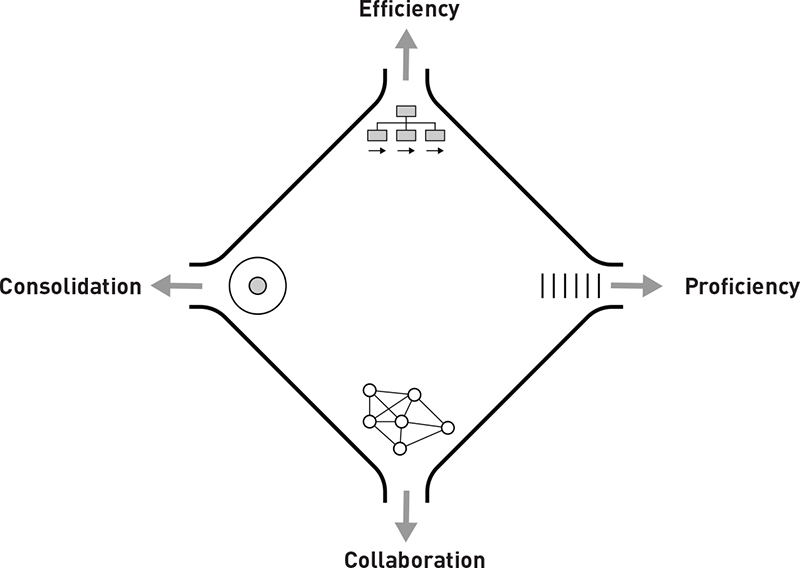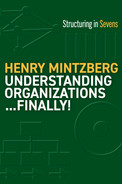CHAPTER 12
A Force for Each Form
For every form there is a prevalent force: consolidation in the personal organization and collaboration in the project organization, efficiency in the machine organization and proficiency in the professional organization. Each of these forces is described here, briefly, because they have already entered the discussion of the four chapters on the forms.

Consolidation in the Personal Enterprise
Usually, the Personal Enterprise has its act together. With its power so concentrated, one person can consolidate the efforts of everyone else.
Moreover, when another form of organization is in crisis, and really does have to get its act together—for example, a machine organization facing bankruptcy—the tendency is to turn to a leader who can best conceive and consolidate the necessary changes. Systems that normally do the consolidating in the machine organization are inadequate under conditions of crisis, and so it may have to revert to a Personal Enterprise for as long as it takes to turn it around. The professional organization, in contrast, usually has little need for consolidation, given that the professionals work rather independently of each other. The project organization may have that need, but normally the networks that connect the projects do that. But in crisis, even the professional and project forms may have to revert to the personal form, however reluctantly, for greater consolidation.
Efficiency in the Programmed Machine
“We need more order around here.” This is the mantra of the machine organization, no matter how much order it already has. Order here usually means efficiency—more output bang for the input buck—to minimize its use of resources, including those human resources. If an organization is organized like a machine, it will focus on efficiency. If, organized differently, it has greater need for efficiency, it will be inclined to reorganize toward the machine form. Either way, the technostructure will plan more activities, impose more measures, tighten the rules.
But within limits. As noted, the Project Pioneer gets its effectiveness by being inefficient, while in the Professional Assembly, efficiency can be the nemesis of proficiency. The Personal Enterprise can usually be made more efficient, but will the chief tolerate all those analysts meddling with his or her organization?
Proficiency in the Professional Assembly
Sheer proficiency is what we look for in our professional organizations—a deft hip replacement, the best meal in town, the perfect double play. Not machine-like efficiency (the most hip replacements/ day), not creative collaboration (a novel hip replacement), not consolidation (linking that hip replacement with the heart transplant next door), but empowering the professionals to be as proficient in their work as they can possibly be.
Collaboration in the Project Pioneer
Collaboration is the favored force in the Project Pioneer, to foster innovation. People usually have to work closely together to come up with novel, customized solutions. Sure, these organizations may need consolidation of their projects. But their natural propensity to network can facilitate that. The members of the project teams certainly need to be proficient, but collaboratively, not independently. As for efficiency, while some is always needed, it hardly encourages innovation.
To conclude: what came first, the force or the form? Well, we need an egg to make a chicken and a chicken to make an egg. Here, too, the force encourages the form and the form gives license to the force. Together they reinforce each other.
